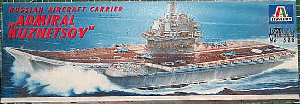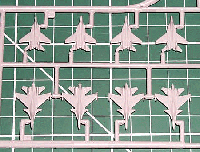 I
normally stick to the standard model scales (1/350, 1/600 or 1/700) but when
this kit came along, I was willing to ease my personal restrictions slightly
(after all, it's nearly 1/700!), as it's a model of a navy I'm getting a nice
little collection of, namely the Soviet/post-Soviet Navy.
I
normally stick to the standard model scales (1/350, 1/600 or 1/700) but when
this kit came along, I was willing to ease my personal restrictions slightly
(after all, it's nearly 1/700!), as it's a model of a navy I'm getting a nice
little collection of, namely the Soviet/post-Soviet Navy. The
box is quite large (47cm x 16cm x 6cm) with reasonable artwork that should provide
a decent reference if original material is unavailable. The instructions are on
a single sheet, double-sided, with the first page giving a short run-down of the
vessel, followed by a side and top profile showing the main colours and decals.
The remainder of the sheet is of the three sprues, numbering all the parts (a
slight waste of space, as the sprues are fully numbered). Turning over, you get
the usual warnings, and the paint list in Model Master and FS numbers (not being
a modeller who uses either of these, I would have appreciated some alternatives,
but this can be worked around). The other ¾ of the sheet is the actual modelling
instructions, broken into three major steps.
The
box is quite large (47cm x 16cm x 6cm) with reasonable artwork that should provide
a decent reference if original material is unavailable. The instructions are on
a single sheet, double-sided, with the first page giving a short run-down of the
vessel, followed by a side and top profile showing the main colours and decals.
The remainder of the sheet is of the three sprues, numbering all the parts (a
slight waste of space, as the sprues are fully numbered). Turning over, you get
the usual warnings, and the paint list in Model Master and FS numbers (not being
a modeller who uses either of these, I would have appreciated some alternatives,
but this can be worked around). The other ¾ of the sheet is the actual modelling
instructions, broken into three major steps.  Part
one is the hull, flight-deck and prop assembly, with information on converting
this full-hull model to waterline. Paint and decal guides are included, and this
is a straight-forward and clear step. Part two concentrates on the island, and
is broken into three stages : the first is the assembly of the major parts; the
second is the addition of the larger detailing; and the final stage is the addition
of the smaller detailing. Again, paint and decal guides are available. While more
cluttered than the first part, this section is again reasonable.
Part
one is the hull, flight-deck and prop assembly, with information on converting
this full-hull model to waterline. Paint and decal guides are included, and this
is a straight-forward and clear step. Part two concentrates on the island, and
is broken into three stages : the first is the assembly of the major parts; the
second is the addition of the larger detailing; and the final stage is the addition
of the smaller detailing. Again, paint and decal guides are available. While more
cluttered than the first part, this section is again reasonable.  Part
three consists of the remaining detailing parts for the hull and flight-deck,
as well as the aircraft (MIG-29 and SU-27 are provided). While looking cluttered
at first, a little study pays off. Again, paint and decal guides are available.
Overall, the instructions are adequate. I would have preferred the part guide
to have been dropped, and more attention paid to the actual assembly instructions,
but I see no major problems from the provided guide.
Part
three consists of the remaining detailing parts for the hull and flight-deck,
as well as the aircraft (MIG-29 and SU-27 are provided). While looking cluttered
at first, a little study pays off. Again, paint and decal guides are available.
Overall, the instructions are adequate. I would have preferred the part guide
to have been dropped, and more attention paid to the actual assembly instructions,
but I see no major problems from the provided guide.  As
I have mentioned decals, let us have a look at them. They are provided on a single
sheet, and there are 26 types on the sheet (some are duplicated, such as the red
stars for the aircraft). A nice feature is the option to have either of the names
on the vessel, together with the relevant pennant number. Seven parking spots
are identified, as are the three main runways, with associated baffles. Quality
is good, with minimal material outside the printing.
As
I have mentioned decals, let us have a look at them. They are provided on a single
sheet, and there are 26 types on the sheet (some are duplicated, such as the red
stars for the aircraft). A nice feature is the option to have either of the names
on the vessel, together with the relevant pennant number. Seven parking spots
are identified, as are the three main runways, with associated baffles. Quality
is good, with minimal material outside the printing. Looking
at the plastic, there are three sprues. The first has the two hull parts, with
plenty of connections to the sprue - the result is a good hull. The only problem
is on the bottom of the hull where some filling will be required (this is caused
by the plastic sinking along the lines of the lugs to mate the two halves), although
this won't bother waterline modellers.
Looking
at the plastic, there are three sprues. The first has the two hull parts, with
plenty of connections to the sprue - the result is a good hull. The only problem
is on the bottom of the hull where some filling will be required (this is caused
by the plastic sinking along the lines of the lugs to mate the two halves), although
this won't bother waterline modellers.  The
second sprue has one major piece and numerous parts. The largest is what will
be the base of the model for waterline usage. The remainder consists of the aircraft
(seven MIG-29s and seven SU-27s), the full-hull supports, the four prop-shafts
and propellers, the rudders, various antennae, liferafts, ships boats, etc. The
only problem on this example is the stern rail piece, where insufficient plastic
went into the mould - the end result is a partial guard-rail in the stern-piece
that will have to be replaced, probably by photo-etch if I have any suitable pieces.
The
second sprue has one major piece and numerous parts. The largest is what will
be the base of the model for waterline usage. The remainder consists of the aircraft
(seven MIG-29s and seven SU-27s), the full-hull supports, the four prop-shafts
and propellers, the rudders, various antennae, liferafts, ships boats, etc. The
only problem on this example is the stern rail piece, where insufficient plastic
went into the mould - the end result is a partial guard-rail in the stern-piece
that will have to be replaced, probably by photo-etch if I have any suitable pieces. The
final sprue has the flight-deck as it's main part, with the remainder being the
main island items, and associated detailing. One thing to note on the flight-deck
- all the decal markings are raised, so you don't have to use the decals themselves
if you prefer not to. I must admit I don't like this "feature", as it means you
have to be absolutely spot-on with the placement, but I guess it's horses for
courses. There is a rectangular hole in the flight-deck; this is for the raising
of one of the three baffles, to allow the simulation of an aircraft ready to depart.
I would have preferred to have one of the hanger lifts to have been in the lowered
position, but this may be possible without too much trouble (it's hard to tell
from the instructions and just looking at the parts; it would have to be investigated
during assembly).
The
final sprue has the flight-deck as it's main part, with the remainder being the
main island items, and associated detailing. One thing to note on the flight-deck
- all the decal markings are raised, so you don't have to use the decals themselves
if you prefer not to. I must admit I don't like this "feature", as it means you
have to be absolutely spot-on with the placement, but I guess it's horses for
courses. There is a rectangular hole in the flight-deck; this is for the raising
of one of the three baffles, to allow the simulation of an aircraft ready to depart.
I would have preferred to have one of the hanger lifts to have been in the lowered
position, but this may be possible without too much trouble (it's hard to tell
from the instructions and just looking at the parts; it would have to be investigated
during assembly).